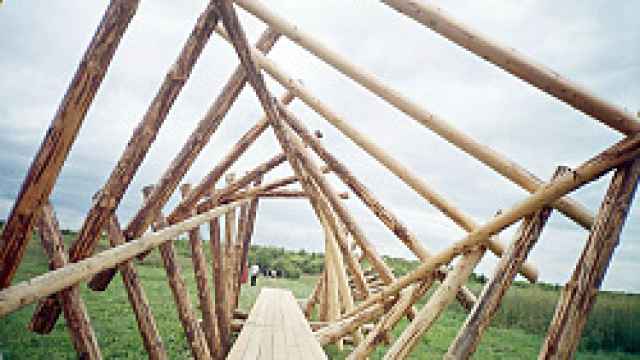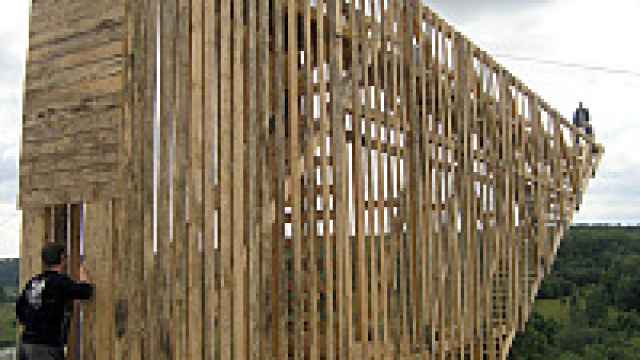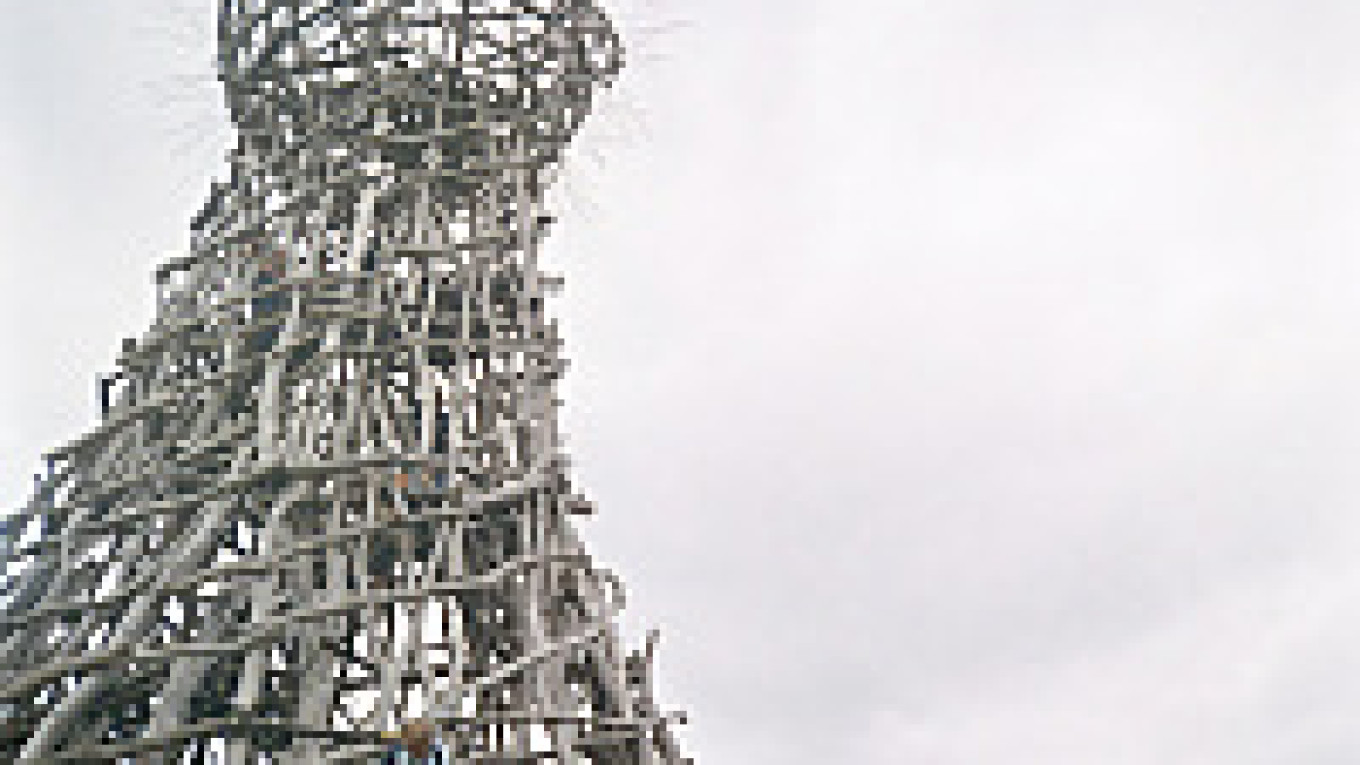Recently, though, the village has come to be associated with physical labor and painstaking handiwork. A six-year-old artists' collective called the Nikola-Lenivets Craftsmen has brought the village fame by building huge structures out of unstripped branches, twigs and logs -- gnarled, woven works of art that are at once futuristic and hauntingly archaic. The group's founder and ideological leader is Nikolai Polissky, an artist who left Moscow for the countryside in the mid-1990s to paint landscapes, but eventually decided to seek out a more radical artistic medium.
Thanks to his efforts, Nikola-Lenivets now stands for art with a social and environmental conscience. Last weekend, the village hosted Arkhstoyaniye, a festival that served as a platform for discussing a wide range of topics, from innovative uses for Russia's park space to finding employment for rural artisans (other than turning out cheap souvenirs) to new directions in contemporary art and architecture.
The event's name is suitably ambitious. It refers to the biggest thing ever to happen in the neighborhood: the standoff, or stoyaniye, against the Tatars. It got its impulse from the management of the relatively new Ugra National Park, which had previously collaborated with Polissky to devise new ways of attracting visitors. These included building armies of snowmen along the riverbank to honor the heroics of the medieval Slavs, as well as hosting a vaguely pagan celebration of the Orthodox Shrovetide, when thatch rockets were launched skyward, leaving a roaring bonfire in their wake.
Last weekend's festival was made possible by a grant from the Vladimir Potanin Charity Fund, which sponsors a program called "Changing Museum in a Changing World." The program is designed to support creative initiatives to keep Russia's cultural institutions relevant.
About 500 architects, critics and curious guests made the four-hour drive southwest from Moscow to attend the festival's opening on Saturday afternoon. After sampling some local delicacies -- homemade vodka and pirozhki -- they set off to explore the exhibition. Objects by 17 architects and architectural bureaus, all from Moscow except for one team from the Netherlands, were displayed on a territory that stretched from the parking lot through groves, fields and clearings to the bank of the Ugra.
The objects were made mostly of wood, and none had an interior frame -- two of the technical requirements decreed by the organizers. The ideological requirements were discussed at a forum on Saturday evening, around a table typical of the Craftsmen's handiwork: It was woven from branches, and a live green sapling sprouted from a hole in the middle.
Art critic Alexander Panov, a curator of Arkhstoyaniye, talked about the importance of ecology for the festival. "The projects could not harm nature in any way," he said. "We're in a national park, let's not forget that."
 Brian Droitcour / For MT The 17 objects built for Arkhstoyaniye had to satisfy two technical requirements: being made of wood and having no interior frames. | |
The designs for Alexei Kozyr's "Bunker" initially drew protests from the park authorities because they involved digging. But the crawl space, situated in the slope of the riverbank and equipped with benches where visitors can sit and admire a sweeping view of the Ugra, is nearly invisible from the outside. It blends in perfectly with its surroundings.
In most cases, the actual construction work was done by the Nikola-Lenivets Craftsmen. Professional carpenters were hired to build complex structures where safety was an issue, like Timur Bashkayev's "Half-Bridge of Hope," a giant wedge that plunges over the outcropping's edge and tapers to nothing at a height of about 10 meters above the ground.
The Craftsmen did not develop or build any projects of their own for Arkhstoyaniye. "If we had used our own resources and decided to do something, it would have blown everyone else away," Polissky said with a smirk. "We sacrificed ourselves for our friends, the stars of Russian architecture."
 Sergei Khachaturov / For MT Timur Bashkayev's "Half-Bridge of Hope" is an enormous wedge that soars 10 meters over the ground. | |
The collective spirit was alive at Arkhstoyaniye, with visitors lending a hand to put the finishing touches on some of the objects. Throughout the afternoon, passersby were asked to pick up a drill and put holes in "Shed," so by nightfall it would glow with thousands of tiny lights when illuminated from within. As a young man perched on a rafter drilling holes in the ceiling, one visitor asked if he was the architect. "Everyone who came and drilled a hole is an architect," the young man replied.
Pavel Lisykhin, the architect whose bureau, Project Meganom, officially got credit for "Shed," said he was surprised by what came out of his bureau's plans. "We thought it would be more theatrical, but it came off as landscape art," he said. "We thought it would come into conflict with its surroundings, but it blended in."
Strict adherence to the architects' plans was never the goal of the Craftsmen. Dmitry Mozgunov, a longtime member of the collective, wasn't shy about tampering. "Of course we added our own ideas," he said. "They didn't order it to be built by just anyone, they ordered it from artists."
The Craftsmen don't look like stereotypical artists, nor do they look like "peasants." The words that Russian art critics often use to describe them give the impression of men in sackcloth and straw hats from a Repin painting, or at least the tractor-driving heroes of Socialist Realism. But in fact they wear tracksuits, sweatshirts and jeans, and during the festival some of them tooled around the park grounds in a shiny white Volga with Russian hip-hop blaring out the windows.
Polissky has been praised for finding a constructive activity for young men in the depressed rural stretches of the Kaluga region. Among other things, he encouraged them to have faith in their own ideas. "When we started, [Polissky] thought everything up himself," said Yevgeny Zelensky, another of the Craftsmen. "Now he offers a couple of ideas, and we think something up ourselves."
Many consider Polissky's real work of art to be the changing attitudes and improving socioeconomic makeup of Nikola-Lenivets and nearby villages -- rather than anything that can be seen or touched. This is underscored by the fact that the objects the Craftsmen build are often transient, like the snowmen that melt and the wooden rockets that go up in smoke.
Lately, the group has been building more things meant to last, such as the sculptures it installed in a park in northwestern Moscow last year, or the objects of Arkhstoyaniye, most of which the Ugra National Park plans to leave up until they erode naturally. But permanence does not necessarily change the meaning of their work.
Panov, the curator, emphasized the importance of the creation process itself as a medium in contemporary art. "It's the synergy of Moscow curators and architects and the local population, the local government and the park administration, that is the artwork, not the dry things left over," he said at the forum. "Those are the rules of the game in the 21st century."
For directions to Nikola-Levinets, where the wooden objects will remain until they erode, see www.arch.stoyanie.ru.
A Message from The Moscow Times:
Dear readers,
We are facing unprecedented challenges. Russia's Prosecutor General's Office has designated The Moscow Times as an "undesirable" organization, criminalizing our work and putting our staff at risk of prosecution. This follows our earlier unjust labeling as a "foreign agent."
These actions are direct attempts to silence independent journalism in Russia. The authorities claim our work "discredits the decisions of the Russian leadership." We see things differently: we strive to provide accurate, unbiased reporting on Russia.
We, the journalists of The Moscow Times, refuse to be silenced. But to continue our work, we need your help.
Your support, no matter how small, makes a world of difference. If you can, please support us monthly starting from just $2. It's quick to set up, and every contribution makes a significant impact.
By supporting The Moscow Times, you're defending open, independent journalism in the face of repression. Thank you for standing with us.
Remind me later.


